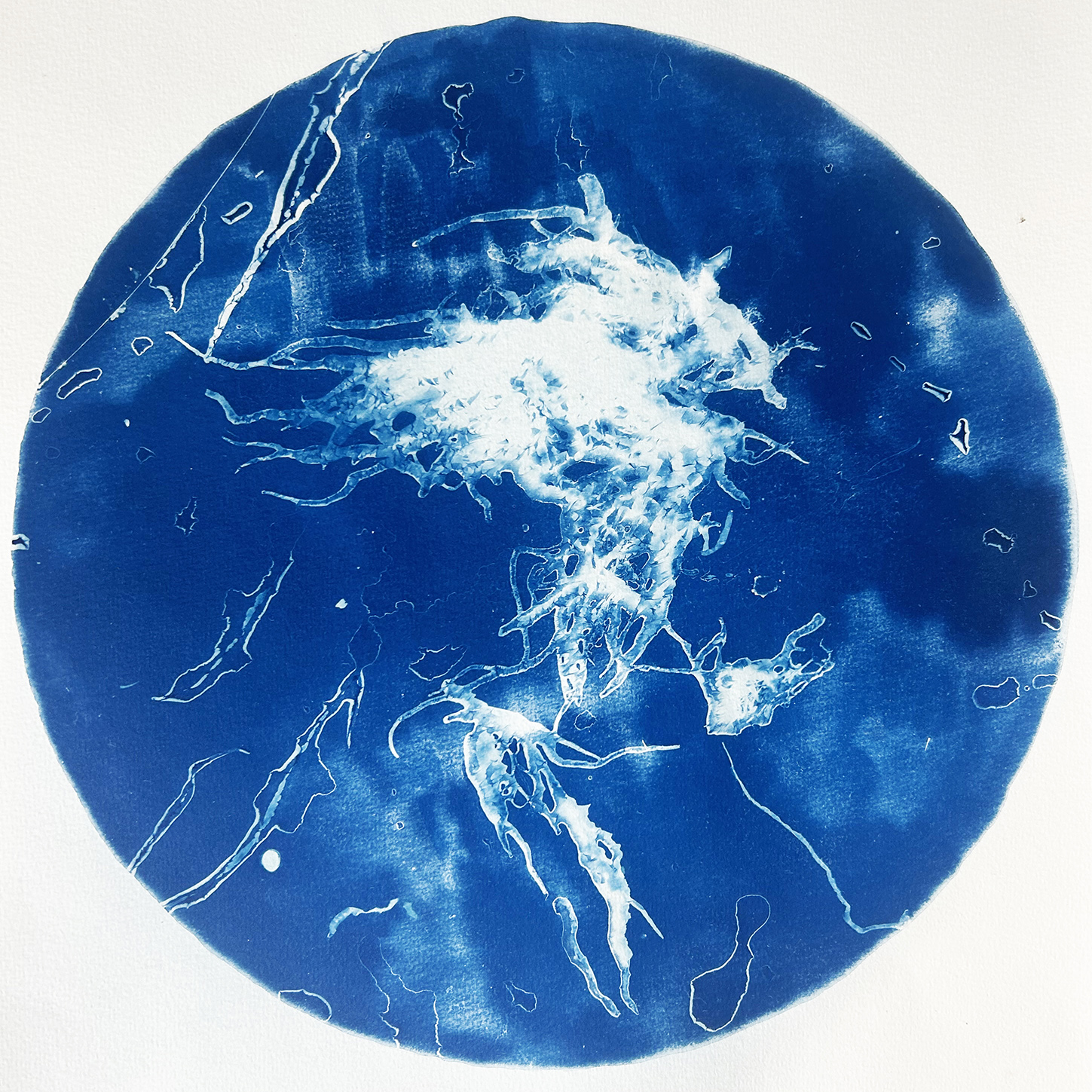6 Jul 2024 → 3 Aug 2024
Thursdays, Fridays and Saturdays: 14:00-17:00
Opening/vernissage:
5 Jul 2024, 17:00-20:00
IMAGE

CYANO by Maja Gade
TEXT
Velkommen til udstillingen CYANO af Maja Gade; en udstilling om livets kredsløb, elementernes materialitet og transfomation.
Den blå farve, cyan, er fælles for ord som cyanobakterier, cyanosis, cyanid og cyanotopi, som bindes sammen i stofskiftet mellem ilt og sollys. Både i naturens kredsløb og i stofskiftet inde i vores krop.
Da cyanobakterier begyndte at producere ilt for 2-3 mia. af år siden ændrede det jordens atmosfære. Det førte bl.a. til at jern i havet begyndte at ruste og banede derved vejen for foto-syntese. Cyanosis er, når der er mangel på ilt i blodet, det kan ses ved at man får blå hud, læber og negle. Man kan f.eks blive kvalt ved cyanidforgiftning, hvor cyaniden forhindrer cellernes transport af ilt rundt i kroppen. Cyanid dufter af mandler og kan findes i planter. Planter bruger sollys og CO2 til at skabe ilt og biologisk materiale, ligesom sollys bruges til at fremkalde billeder med cyanotopi.
På udstillingen kan man opleve tegninger, akvareller og cyanotopier, som handler om kredsløbet mellem ilt, mineraler og sollys. Motiverne kredser om mineraler, planter og alger; fra jerns mineral-struktur gennem fraktaler til grønkorn. Det kan ses som en bevægelse fra mineraler til planter, hvor kredsløbet mellem mineraler, planter og ilt bliver det centrale:
Hvordan liv, i form af f.eks. cyanobakterier, skaber ilt, som binder sig til jern og danner rust. Og hvordan alger, der hyldes som terraformers, påvirker havet og atmosfæren på godt og ondt. Ved at udlede ilt skaber algerne brændstof til en masse liv, men er der for mange alger skaber de iltsvind, som dræber liv i havet.
Med CYANO undersøger Maja Gade livets kredsløb både ved brugen af materialer, de metoder der bruges til fremstillingen af værkerne, og de motiver som vises; hvor den cyanoblå farve gennemsyrer udstillingen både visuelt og i overført betydning.
--
CYANO er kurateret af Anne Munnecke og er en del af udstillingsprogrammet The Kinship Programme, som finder sted i 2024 på c4 projects.
Udstillingen er venligst støttet af Statens Kunstfond, Augustinus Fonden, Beckett-Fonden, Aage og Johanne Louis-Hansens Fond og Københavns Kommune – Rådet for Visuel Kunst.
//
c4 projects presents the exhibition CYANO by Maja Gade; an exhibition about the cycle of life, the materiality of the elements, and transformation.
The color blue, cyan, are found in words like cyanobacteria, cyanosis, cyanide, and cyanotype, which are connected to metabolism between oxygen and sunlight. Both in nature's cycles and in the metabolism inside our bodies.
When cyanobacteria began producing oxygen 2-3 billion years ago, it changed the Earth's atmosphere. This led to, among other things, iron in the sea beginning to rust and thereby paved the way for photosynthesis. Cyanosis is when there is a lack of oxygen in the blood, which can be seen as blue skin, lips, and nails. One can, for example, be suffocated by cyanide poisoning, where cyanide prevents the cells' transport of oxygen throughout the body. Cyanide smells of almonds and can be found in plants. Plants use sunlight and CO2 to create oxygen and biological material, just as sunlight is used to develop images with cyanotype.
At the exhibition, one can experience drawings, watercolors, and cyanotypes, that examines the cycle between oxygen, minerals, and sunlight. The motifs revolve around minerals, plants and algae; from the mineral structure of iron through fractals to chloroplasts. It can be seen as a movement from minerals to plants, where the cycle between minerals, plants, and oxygen becomes central:
How life, in the form of, for example, cyanobacteria, creates oxygen, which binds to iron and forms rust. And how algae, that are celebrated as terraformers, impact the sea and atmosphere for better or worse. By releasing oxygen, algae create fuel for a lot of life, but if there are too many algae, they create oxygen depletion, which kills life in the sea.
With CYANO, Maja Gade examines the cycle of life both through the use of materials, the methods used in creating the works, and the motifs displayed; where the cyan-blue color permeates the exhibition both visually and metaphorically.
--
CYANO is curated by Anne Munnecke and part of the exhibition program The Kinship Programme, which takes place in 2024 at c4 projects.
The exhibition is kindly supported by Statens Kunstfond, Augustinus Fonden, Beckett-Fonden, Aage og Johanne Louis-Hansens Fond, and Københavns Kommune – Rådet for Visuel Kunst.